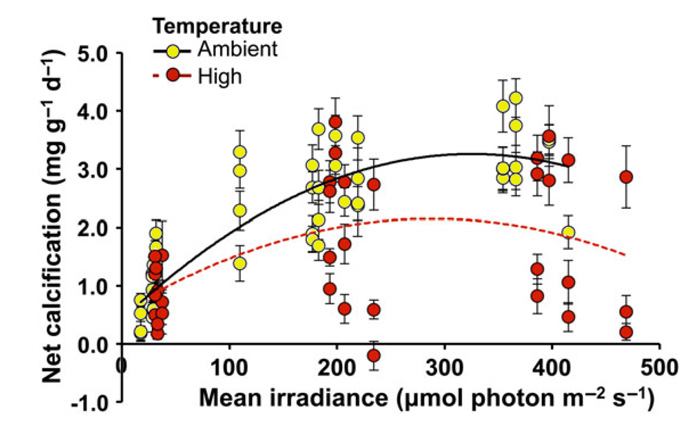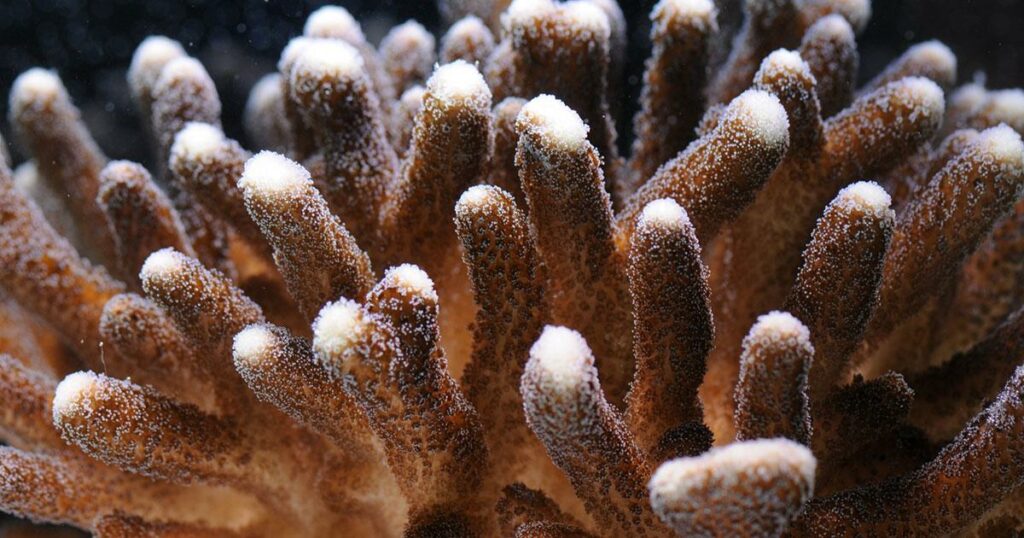From the CO2Science archive: Many are the studies that seek to understand the response of marine life to possible future conditions of ocean acidification and warming. The latest such study to catch our attention comes from Bahr et al. (2017), but not quite in the manner that one might think; it is what this study did not find that was of interest to us.
Paper reviewed: Bahr, K.D., Jokiel, P.L. and Rodgers, K.S. 2017. Seasonal and annual calcification rates of the Hawaiian reef coral, Montipora capitate, under present and future climate change scenarios. ICES Journal of Marine Science 74: 1083-1091.
Working with specimens of Montipora capitata, Bahr et al. investigated the “direct and interactive effects of temperature, irradiance, and pCO2” on the growth of this important Hawaiian reef building coral. Their work was accomplished at the Hawaii Institute of Marine Biology, University of Hawaii, in a mesocosm system that represented present and projected conditions of climate change, including 12 experimental regimes consisting of two temperature levels (ambient and +2°C), three irradiance conditions (ambient, 50% reduction and 90% reduction) and two pCO2 values (ambient and twice ambient). Over a period of approximately two years, several replicates of the various treatment conditions were conducted in which the authors measured net coral calcification and through statistical analysis were able to untangle its relationship between these three factors.
Results of the analysis revealed that temperature and irradiance were the primary factors driving net calcification of M. capitata (see the curvilinear response shown in Figure 1 below) and that “the effect of pCO2 acting alone and/or with other predictors did not contribute to the multiple regression model.” Given such findings, Bahr et al. write that “ocean warming in shallow water environments with high irradiance poses a more immediate threat to coral growth than acidification for this dominant coral species.” In all actuality, however, it would appear that ocean acidification poses no threat to M. capitata since its influence carried no predictive power in their regression model of factors influencing net calcification. Thus, we find yet another study that does not support the ocean acidification scare stories of corals wasting away in the future because of rising atmospheric CO2.

Figure 1. Net calcification of M. capitata vs. mean irradiance at optimal ambient temperatures (23-27°C, yellow circle) and suboptimal high temperatures (27-31°C, red circles) under ambient pCO2 regimes. Adapted from Bahr et al. (2017).



Drawing lines on such scattered data is meaningless. You don’t throw darts at a calendar and say “the average date was determined to be….so next month it’s going to be…..”. Stats graphers are guilty of this all the time. If the data shows that a best line curve fit does not result in predictability, basically the line should not be plotted on the graph,…lest it affect the judgement of the simple- minded. But it’s done all the time anyway…..a mistake so common that it can’t be fixed.
The effect can be absolutely real but the R-squared can be low (say 7%), you would get your "line through scattered data". It means that the effect may not explain much of the phenomena, you are likely missing other factors from your model. In this case the statistical analysis said that pCO2 was not a factor explaining their experimental data? Could be that their experiment is flawed, failed to realistically replicate the real Ocean.
This is about corals. These are highly resilient and adaptive organisms. Due to the way they breed they will always quickly (evolutionary) select for the best performing specimens. In a stable environment, they will have optimal biological function (yellow dots).
If you place existing colonies in a different environment, the previously stable group will show a high diversity in performance, including specimens that are doing just as well as before (red dots). If they stay in this warmer environment and are allowed to breed naturally, in a few years you will see that the red dots will follow the yellow 'optimal' line again.
But if you then place this group back in the colder water, they will show the highly diverse performance since they are now adapted to warmer waters.
Corals are truly amazing things.
The corals aren’t and never were in any danger
That is the story